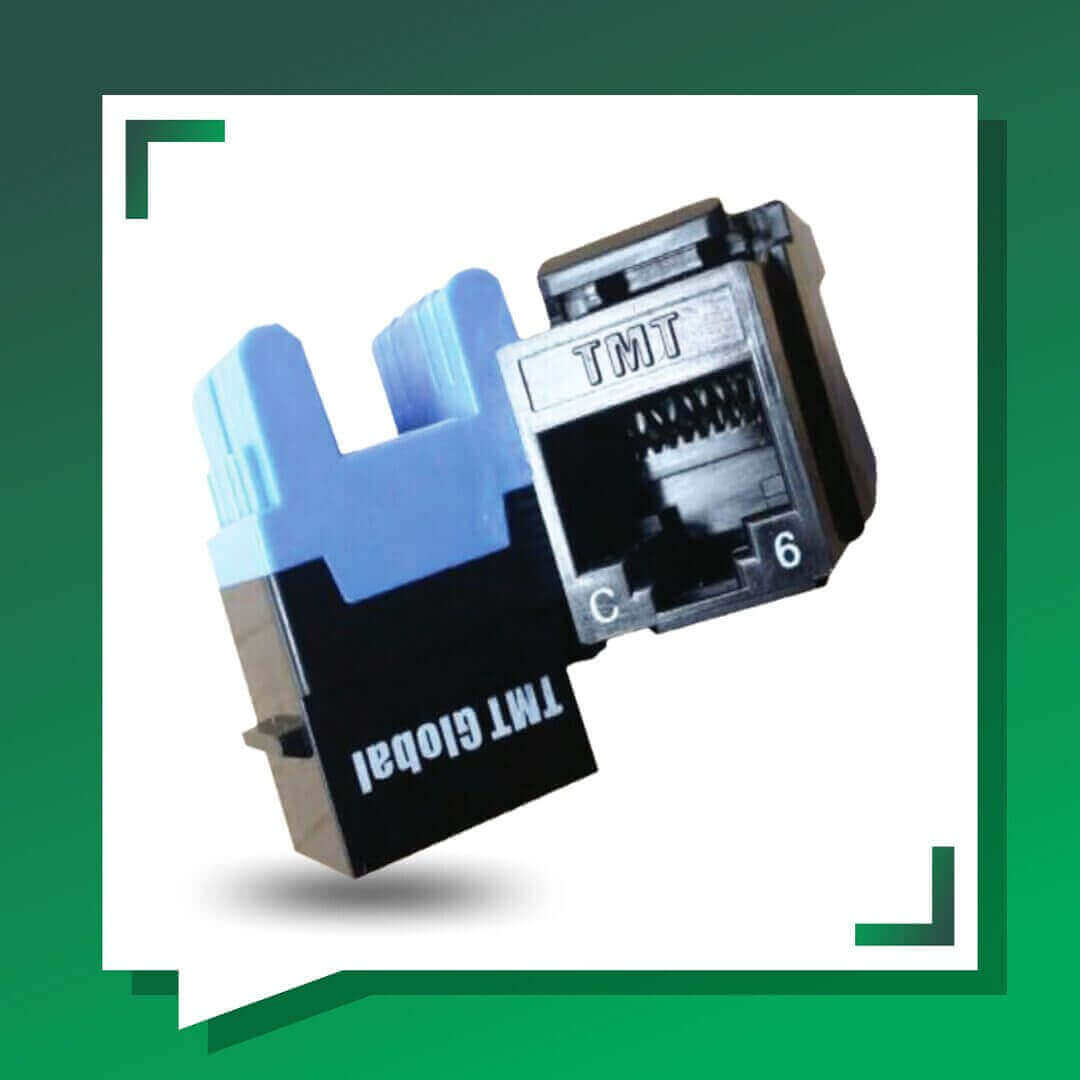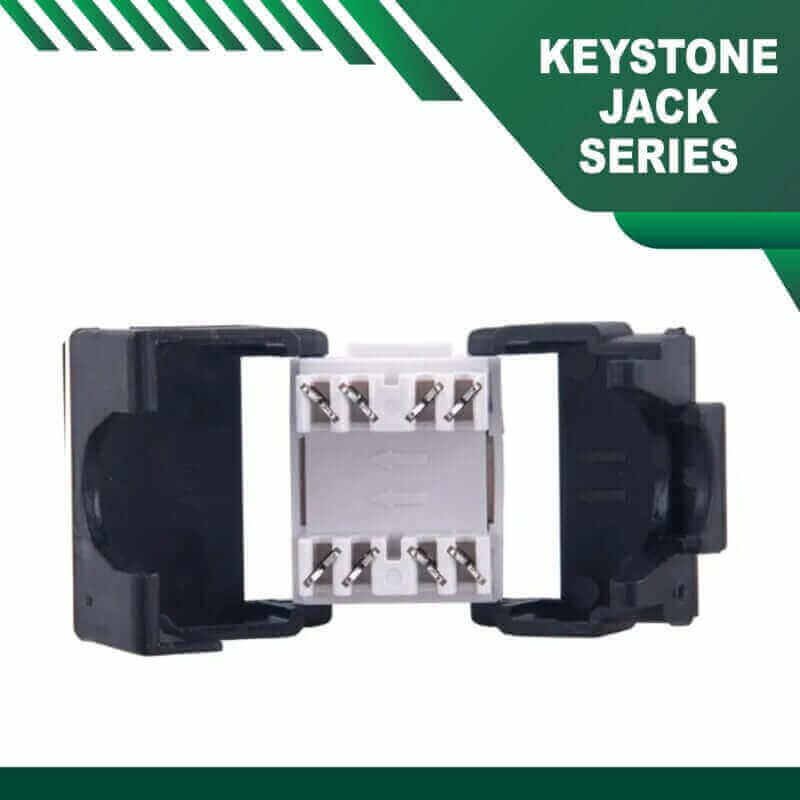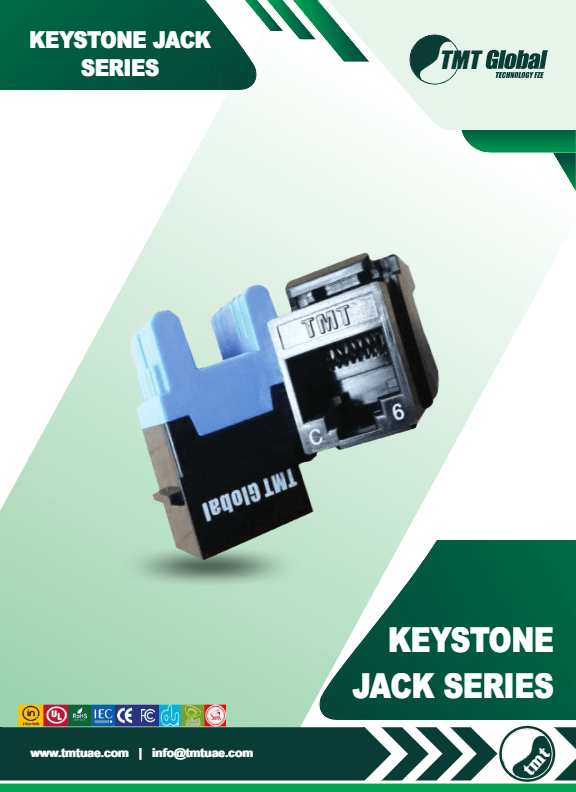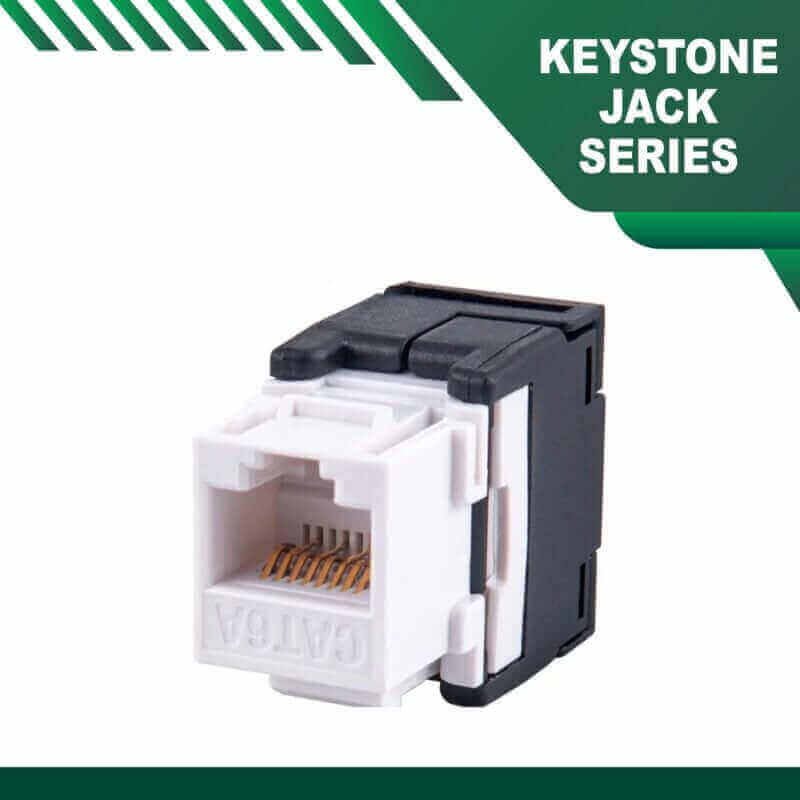Understanding Keystone Jacks: A Comprehensive Guide by TMT Global Technology Ltd UK

What is a Keystone Jack?
Keystone jacks are small, modular connectors that play a vital role in structured cabling systems, serving as interfaces for various types of cables. These components are typically mounted in a wall plate or patch panel and facilitate the connection of network and telecommunications lines. Their design allows for easy installation and replacement, making them essential for ensuring efficient data transmission within both residential and commercial environments.Keystone Jacks
Primarily utilized in networking applications, keystone jacks accept a range of cable types, including Ethernet, fiber optic, and audio/video cables. In an increasingly interconnected world, these jacks help bridge the gap between devices and networks, supporting high-speed data transfer and communication. Different categories of keystone jacks exist, each tailored for specific applications. For instance, Cat 5e, Cat 6, and Cat 6a jacks cater to various networking needs, with enhancements in performance and speed as one ascends in category.



Additionally, keystone jacks come in different styles, including standard, angled, and blind keystone jacks. Standard jacks are typically used for direct connections, while angled jacks can facilitate better cable management by reducing strain on cables. Blind keystone jacks are often utilized to fill unused slots in a panel, maintaining a neat appearance and preventing dust accumulation. Furthermore, some keystone jacks are available with color-coded designs, allowing for easy identification and organization within networking systems.
In summary, keystone jacks are essential components in modern structured cabling systems, offering versatility in applications ranging from home networking to sophisticated telecommunications infrastructure. Their various types and designs allow for customized solutions tailored to specific networking requirements, supporting seamless connectivity across different platforms.
The Importance of Keystone Jacks in Networking
Keystone jacks play a pivotal role in establishing reliable network connections in modern infrastructure. As an essential component of structured cabling systems, these devices facilitate the connection between various network devices and ensure the smooth transmission of data. By serving as the interface between cables and network equipment, keystone jacks contribute significantly to the overall performance and functionality of networking setups.
One of the primary benefits of employing keystone jacks is the enhancement of signal quality. High-quality keystone jacks help minimize signal loss and interference, crucial parameters for maintaining optimal network performance. The integrity of signals becomes particularly important in environments with numerous electronic devices, where electromagnetic interference can easily degrade performance. Thus, selecting the right keystone jacks can lead to a more stable and faster network connection.
Flexibility in cabling setups is another key advantage associated with keystone jacks. These devices can be easily installed into various wall plates and patch panels, allowing network administrators to customize and adapt their cabling systems according to specific needs. With keystone jacks, organizations can switch out cables quickly and efficiently without disrupting operations, saving time and reducing downtime. This adaptability also plays a significant role in network planning, enabling future upgrades or modifications.
Moreover, keystone jacks are highly compatible with various network devices and cabling standards. Whether utilizing Ethernet cables for local area networks or fiber optic cables for wider connections, keystone jacks provide a reliable solution across different technologies. This compatibility ensures that regardless of the specific networking hardware in use, keystone jacks will integrate seamlessly, thus promoting overall efficiency and effectiveness in networking configurations.
Features of TMT Global Technology Keystone Jacks
TMT Global Technology Ltd stands out in the market for keystone jacks due to several distinctive features that underscore their commitment to quality and performance. One of the primary aspects is the exceptional build quality of their products. These keystone jacks are crafted using high-grade materials, ensuring durability and resistance to wear over time. This focus on build quality guarantees that the jacks maintain their integrity even in high-traffic or demanding environments, making them ideal for both residential and commercial applications.
Another significant feature of TMT Global Technology RJ45 CAT6 is their advanced design. Unlike many competitors, TMT’s jacks are engineered for ease of use, facilitating straightforward installation. The design takes into account the common challenges faced by installers, allowing for rapid deployment without compromising on connectivity or performance. The compact form factor ensures that these jacks can easily fit into standard wall plates, maintaining consistency and aesthetic appeal in wall-mounted setups.
Furthermore, compatibility is a cornerstone of TMT’s RJ45 CAT6, which seamlessly integrate with various standard wall plates. This universal compatibility minimizes the need for special adapters or additional equipment, streamlining the installation process. TMT also prioritizes performance metrics, as these RJ45 CAT6 are designed to support high-speed data transmission. This feature is critical in today’s data-driven world, where low latency and high bandwidth are essential for applications ranging from home networking to enterprise solutions.
In summary, TMT Global Technology Ltd’s RJ45 CAT6 offer an unmatched combination of build quality, innovative design, broad compatibility, and superior performance metrics, positioning them as a leading choice in the competitive landscape of networking solutions.
Installation Process of Keystone Jacks
Installing RJ45 CAT6 is a straightforward process that, when followed correctly, ensures optimal connectivity for your network. To begin, gather the necessary tools: a keystone jack, a compatible wall plate, a punch-down tool, wire cutters, a cable strip, and a screwdriver. Additionally, ensure you have the appropriate category of Ethernet cable (Cat5e, Cat6, etc.) aligned with your networking needs.
Before starting the installation, prepare your workspace by making sure the area is clean and well-lit. First, measure the distance from your patch panel or switch to the location where the keystone jack will be installed. Cut an appropriate length of the Ethernet cable, making sure to leave some extra slack for adjustments. Once cut, use the cable stripper to carefully remove about two inches of the outer insulation, exposing the four twisted pairs inside. It is important not to untwist the pairs more than necessary as this can affect performance.
Next, separate the twisted pairs and arrange them according to the wiring standard you are following (T568A or T568B). Take the time to ensure that each wire is neatly arranged to minimize confusion during the termination process. Insert the arranged wires into the appropriate slots of the keystone jack, ensuring they are fully pushed down into the contact points. Use the punch-down tool to secure the wires in place, cutting off any excess wire that protrudes from the back of the jack.
After making all connections, insert the keystone jack into the wall plate, then secure it in place using the screws provided. Finally, attach the wall plate to the wall, ensuring that it is flush and secure. Testing the installation with a cable tester can confirm that everything is functioning correctly before you put your network into operation. Following these best practices will help ensure reliable connectivity through the RJ45 CAT6.
Common Applications of RJ45 CAT6
RJ45 CAT6 are versatile components used in various applications across diverse environments, making them indispensable in modern technology configurations. Their primary function is to provide a flexible connection point for audio-visual and data network systems, which enhances their usability in residential, commercial, educational, and technical infrastructures.
In residential settings, keystone jacks are often utilized to create organized and efficient home network setups. Homeowners can easily integrate multimodal connections for devices such as computers, gaming consoles, and smart TVs, utilizing RJ45 CAT6 to facilitate seamless access to high-speed internet and multimedia. These jacks can also be employed in wall plates or patch panels, allowing for easy changes in home connectivity requirements.
In office environments, the use of RJ45 CAT6 is prevalent for establishing high-capacity data networks that support a range of applications. They provide structured cabling systems that enable businesses to maintain a reliable network, accommodating the growth of communication technology without rerouting extensive cables. This adaptability aids in optimizing workflow and enhances productivity through efficient data transfer and communication.
Data centers, characterized by their complex configurations, benefit significantly from RJ45 CAT6. Here, they enable organized cabling that prioritizes maintenance and scalability. Keystone jacks facilitate connections between servers, switches, and various components of storage systems, promoting efficient heat dissipation and minimizing downtime during server upgrades or modifications.
Educational institutions also leverage the functionality of RJ45 CAT6 in classrooms and laboratories. By employing these versatile connections, schools can enhance their learning environments through advanced technological tools. Audio-visual systems become more integrated, offering opportunities for real-time presentations, interactive lessons, and improved communication between educators and students.
Troubleshooting Keystone Jacks
When dealing with RJ45 CAT6, it is essential to address potential issues efficiently to maintain network integrity and functionality. Connectivity problems often arise due to improper installation or damage to the keystone jack itself. Ensuring that each cable termination is secure and properly aligned is crucial. A common troubleshooting technique involves visually inspecting the keystone jacks for any signs of physical damage, such as cracks or bent pins, which can significantly affect performance.
Another frequent issue users encounter is signal degradation. This can manifest as intermittent connectivity or reduced data transmission speed. To effectively diagnose this problem, technicians may perform a continuity test using a cable tester. This device checks the wiring continuity and identifies any wiring faults within the keystone jacks or the connected cables. It is advisable to check for cable length and quality, as excessively long runs or inferior cabling can contribute to signal loss as well.
If connectivity issues persist, it may be necessary to swap the existing keystone jack with a known good unit. This method allows for the identification of defective units that may be causing the problems. Additionally, it is important to ensure that all keystone jacks are compatible with the type of cabling used, whether they are Category 5e, Category 6, or others. Mismatched components can lead to performance issues that can be easily overlooked during installation.
In troubleshooting keystone jacks, it is vital to approach the problem systematically. Documenting each step taken can help identify trends or recurring issues, ultimately leading to a more efficient resolution process. Ensuring that best practices are followed during installation and maintenance can reduce the likelihood of problems arising in the future.
Comparing Keystone Jacks to Other Connectivity Options
When assessing connectivity solutions for networking, keystone jacks present a viable choice among several alternatives, including patch panels and direct connections. Each option has its unique advantages and disadvantages, which should be carefully weighed depending on the specific application and requirements.
Keystone jacks, known for their versatility, allow users to create customized connectivity through wall plates, enabling a variety of connectors to be integrated into the same system. This modular approach can significantly simplify maintenance because individual jacks can be replaced or upgraded without extensive rewiring. In contrast, patch panels serve as central hubs in a structured cabling system, where numerous connections converge. While patch panels often require more upfront investment due to their size and complexity, they can yield a tidy organizational structure that is beneficial in larger setups where numerous cables intersect.
Direct connections simplify setups by linking devices straight to the network, often resulting in enhanced performance and reduced latency. However, this method can limit flexibility, making modifications or expansions cumbersome. Keystone jacks provide a compromise by offering decent performance while ensuring that future changes can be made with relative ease. The installation complexity is another essential consideration; keystone jacks, generally requiring less effort than setting up a patch panel, provide a straightforward approach that can be advantageous for smaller applications.
In terms of cost, keystone jacks tend to have a lower upfront expense compared to patch panels. Yet, when evaluating overall costs, one must also consider the long-term maintenance and potential expansion needs of the network. Ultimately, choosing the right connectivity solution will depend on the specific use case, budgetary constraints, and desired performance level, making it essential to thoroughly evaluate all available options.
TMT Global Technology Ltd: An Overview
TMT Global Technology Ltd stands as a prominent player in the telecommunications industry, recognized for its steadfast commitment to quality and innovation. Established with a vision to enhance connectivity solutions, the company has carved out a significant niche in developing advanced telecommunications technologies. Over the years, TMT Global Technology Ltd has built a reputation for reliability and excellence, positioning itself as an industry leader.
The organization’s mission is to deliver high-performance connectivity solutions that not only meet but exceed the evolving demands of businesses and consumers alike. They aim to bridge the gap in communication technologies, ensuring seamless data transmission through innovative products. By emphasizing research and development, TMT Global Technology Ltd consistently introduces cutting-edge technologies designed to optimize network performance and enhance user experience.
TMT Global Technology Ltd’s product range is extensive, with a focus on delivering solutions that cater to diverse connectivity needs. Their portfolio includes various telecommunication equipment, such as keystone jacks, patch panels, and structured cabling products. Keystone jacks, in particular, exemplify the company’s dedication to providing high-quality connectivity solutions that facilitate efficient data transmission. These components are engineered to provide reliable performance across various applications, from residential networks to complex enterprise setups.
As an industry leader, TMT Global Technology Ltd also prioritizes customer satisfaction and technical support, ensuring that clients receive guidance throughout their connection and installation processes. This commitment to service, combined with their innovative approach to product development, underscores their status as a trusted partner in the telecommunications landscape. With a forward-thinking ethos, TMT Global Technology Ltd is poised to continue shaping the future of connectivity solutions.
Future Trends in Keystone Jack Technology
As the demand for faster and more reliable data transmission continues to grow, the keystone jack technology is evolving rapidly. One of the most significant trends is the advancement in materials used for manufacturing these components. Manufacturers are increasingly utilizing high-grade materials such as enhanced plastics and metals that offer superior durability and conductivity. These developments not only enhance performance but also reduce the overall environmental impact, as new materials often include recycled components or are more easily recyclable.
Another notable trend is the design of keystone jacks aimed at supporting higher data rates. With the advent of technologies like 5G and Wi-Fi 6, there is a pressing need for connectors that can handle increased bandwidth. Innovations in keystone jack designs, such as improved shielding and advanced termination techniques, minimize signal loss and interference, thereby facilitating seamless transmission of large data volumes. As these technologies mature, we can expect keystone jacks to integrate fully with systems that need to manage high-definition video streaming and other bandwidth-heavy applications with ease.
Furthermore, the integration of keystone jacks with smart home technology is an exciting development on the horizon. As homes become increasingly automated, the need for versatile and reliable connectivity solutions will rise. Keystone jacks are being reimagined to work in conjunction with smart devices, offering features such as automated network switching and enhanced security protocols. These advancements pave the way for a more connected and intelligent home environment where data management is performed effortlessly.
In conclusion, the future of keystone jack technology looks promising, driven by advancements in materials, design specifications for higher data rates, and smart home integration. As these innovations unfold, they will undoubtedly shape a more efficient and robust industry, catering to the growing needs of consumers and businesses alike.
